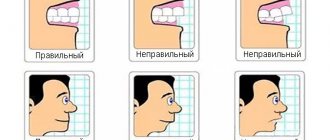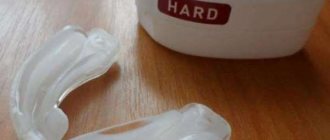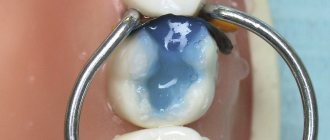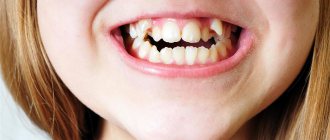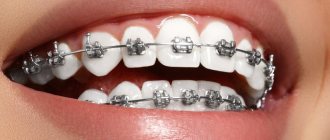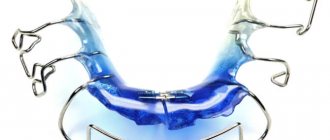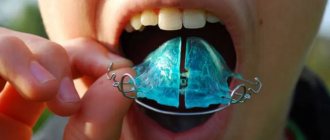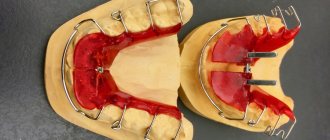Dental trainers are a type of myofunctional correctors that are used to correct bites along with classic plates and brace systems that are already familiar to everyone. The main feature of trainers is that they not only remove the consequences - they correct incorrectly formed teeth, but work with the cause: they help develop the jaw muscles, remove excess pressure on the bones, form correct nasal breathing, and tongue position. That is why this method of treatment is considered more promising.
Indications for the use of dental trainers
A dental trainer is usually prescribed to be worn in the following situations:
- a person cannot have braces installed for one reason or another;
- the bite has formed incorrectly;
- swallowing is impaired;
- teeth are displaced;
- often stuffy nose due to problems in the oral cavity;
- complexes or profession do not allow wearing other systems;
- there are speech therapy problems, etc.
Sometimes, if a doctor sees that a patient is at risk of malocclusion, he will prescribe a dental trainer as a preventive measure.
Read in detail about problems with bite here: All about bite: what it is like
Reviews
Modification of the TMJ joint splint quickly corrects many temporal joint dysfunctions. The combination of unique design, treatment effectiveness, and affordable cost makes its use in demand.
You can talk about your experience in eliminating joint problems using this device or express your opinion regarding the effectiveness and rationality of using the splint by leaving a comment on this article.
If you find an error, please select a piece of text and press Ctrl+Enter.
Tags bite trainers
Did you like the article? stay tuned
Previous article
Restoration of pulpless teeth using Unimetric pins
Next article
Optragate in dentistry – easy for the specialist and comfortable for the patient
Who should not wear trainers?
The systems described are primarily medical devices, so if you are impressed by the various photos before and after the trainer and want to buy such a device for yourself, be sure to consult with your doctor. Self-treatment with a trainer is dangerous and can cause harm.
There are other situations when it is better to choose another treatment option:
- if there is nasal congestion, which has become chronic (the patient simply will not be able to train at full strength, because he will have breathing problems);
- when the bite of the teeth in the lateral areas is cross;
- if a trainer is chosen for a child , but the child is uncontrollable and does not obey his parents (classes must be on schedule, otherwise there will be no effect).
In the described cases, it is better to use braces to correct a malocclusion.
Pros and cons of treatment with trainers
Why are dental trainers for adults and children so popular? This system has many advantages that make it popular and convenient. The main advantages of treatment using such structures:
- low price. The most budget trainer is very cheap, and modern improved models still cost 3-4 times less than an inexpensive brace system;
- ease of care. The patient does not require any special cleaning products or devices - just toothpaste and a brush are enough;
- versatility. The trainer does not need to be made specifically taking into account the patient’s characteristics; you just need to choose a model by size;
- wearing does not have a negative effect on the enamel or soft tissues, the devices do not injure the tongue or gums;
- In addition to bite, trainers also solve other problems, for example, correcting speech (in cases where diction problems were caused by incorrect dentition);
- the patient experiences minimal discomfort while wearing.
An additional advantage of trainer systems is that they do not cause any psychological discomfort: the trainer can be removed at any time to eat, drink or go to an important meeting. However, this method of changing the bite also has its disadvantages:
- slow effect. You need to wear the trainer for at least a year to see real results;
- prohibition on eating and drinking while wearing. If you take a trainer for a child , this can become a serious problem;
- Treatment must be carried out strictly according to schedule and for the required amount of time per day, otherwise there will be no effect. This option is only suitable for responsible people, and children should be supervised by parents.
Trainer effect: before and after
Design
The dental TMJ device is an arc-shaped element made of high-quality medical silicone, which is resilient and elastic.
It is characterized by increased resistance to chemical destruction and does not wear out, which guarantees its long service life.
The size of the trainer is selected individually. It should be remembered that the patient’s comfort will depend on the correct selection of the dimensions of the device.
On both sides of the device there are built-in special stabilizers for the tongue, which control its fixation, providing complete protection against biting.
Thanks to the wing-shaped side configuration, the dental device creates a pressure reduction, relaxing muscle tension. It is characterized by rapid adaptation to the individual characteristics of the jaws of any person, without causing allergies or discomfort when worn. It is selected by an orthodontist at the patient’s first appointment.
The design of the splint is thought out in such a way that when the device fits tightly to the dentition, it does not cause any inconvenience associated with articulation . Colorless medical grade silicone ensures discreet wearing.
In what cases is wearing the Biderman apparatus prescribed and the principle of its operation.
Come here to take a closer look at the design of the Muehlemann propulsor.
At this address https://orto-info.ru/sistemyi-vyiravnivaniya-zubov/individualno-izgotovlennyie-apparatyi/vo-vremennom-prikuse-haasa.html we will talk about the purpose of the Haas apparatus in orthodontics.
Types of dental trainers
Modern trainers for teeth straightening are classified according to different criteria. There are soft models, products of medium and high hardness. Each type is created for its own case. For example, an initial trainer is a soft structure that is used for treatment in the first stages, and a retainer is a model that allows you to consolidate the results of previous treatment. Let's look at the most popular types of trainers for dentition correction.
Pre-orthodontic children's trainers
Dental trainers for children are called pre-orthodontic and are used on the primary dentition. They are divided by age: for small children it is recommended to buy the Infant model (4-6 years old), for children from 6 to 10 years old there is already a more adult model - T4K, which takes into account the change of milk teeth to permanent ones.
Trainer Infant
A children's trainer is sometimes used even if there is no malocclusion. It is prescribed in the following cases:
- mouth breathing;
- increased tone of the temporomandibular joint;
- bad habits that negatively affect the dentition (for example, thumb sucking in your sleep);
- asymmetrical teething, etc.
The first trainer - the initial one - is made of soft silicone, which adapts to the child’s oral cavity. It is left overnight and used for 8-9 months. The second trainer – therapeutic – has a rigid frame and is installed for a year or more. Sometimes a child has to wear the system until he is two years old.
There are also special children's dental trainers that help avoid malocclusion in the event of early loss of primary incisors, canines, and molars. They are prescribed from the age of 3 years for the entire period while permanent teeth are being cut.
Finish Trainers
A final orthodontic dental trainer or retainer is usually prescribed for adolescents between 10 and 13 years of age. It is used for several purposes:
- consolidate the result after treatment with braces or other methods;
- allow weakened enamel to recover faster by protecting it from bad habits;
- form correct swallowing, reduce increased tone of the facial muscles.
Doctors often use a finishing type trainer to correct the not entirely correct position of teeth after unprofessional installation of a brace system.
Finish Trainers
Joint trainers
A joint trainer or joint splint is a device that reduces or eliminates pain due to dysfunction of the temporomandibular joint (TMJ) and relaxes tense muscles of the face and neck. At the same time, it also protects your teeth if you or your child have a habit of grinding them in their sleep.
Thanks to its arc shape, the articular trainer corrects the position of the lower jaw, and the soft material allows the device to easily adapt to any characteristics of the patient.
Joint trainer
Trainers for braces
A trainer for braces is a special type of medical device. It allows you to combine the stages of instrumental and functional treatment, increasing the effectiveness of both approaches. As a result, the result of treatment with braces becomes more stable, and the process itself goes faster.
Benefits of wearing a braces trainer :
- helps relieve muscle pressure;
- protects the oral cavity from damage from braces during the night;
- eliminates bad habits, which reduces the risk of re-developing dental problems.
Examples of such devices can be viewed in our catalog: Trainers for braces
Trainer for braces
Trainers for adults
Trainers for adults are used less frequently, but are also quite popular. The structure of the models is very similar to teenage ones, but a little more complicated. A standard hard trainer for an adult consists of the following elements:
- lip bumper, which reduces the tone of the facial muscles;
- a central stop that sets the correct position of the tongue;
- enlarged lateral edges, due to which the temporomandibular joint is supported.
Products are also divided by hardness: at night a soft model is used, and during the day it is recommended to train with a hard one.
An additional advantage of trainers for adults is that they successfully combat snoring.
Trainer for adults
Price
It is difficult to name the exact cost of the device. This figure, depending on the place of purchase, ranges from 3.5 thousand rubles. up to 4.5 thousand rubles
It is also important to take into account the fact that you will additionally have to pay for a consultation and x-ray, which is about another 1 thousand rubles.
Several other factors influence the cost of treatment:
- doctor's qualifications;
- status of the medical institution;
- the region of its location;
- pricing policy.
The exact cost of eliminating disorders in the TMJ should be found in the dental clinic where treatment is planned..
The video provides additional information on the topic of the article.
Why trainers are better than other orthodontic devices
Compared to other orthodontic devices, teeth straightening trainers benefit in three ways:
- They do not need to be worn constantly like braces. Therefore, you don’t have to limit yourself in communication or refuse to work with people. At school, children will not suffer from ridicule from classmates;
- they do not put pressure on the teeth. Braces and plates affect the teeth, destroying the enamel and injuring, irritating the mucous membrane;
- they are much cheaper and do not require individual production. The patient can buy a trainer in a store (for example, choose it from the catalog on our website) and immediately start wearing it.
Another plus is that you don’t have to wait for the trainer to be made. All you need to do is ask your doctor which model and size you need, and order it in the store. This is also different from braces, the installation of which takes a lot of time.
How to put on and wear a trainer correctly. How long does it take to get used to
Adult and children's dental trainers are put on and worn the same way. Installing the device is quite simple:
- Place the device in your mouth so that the central stop is directed towards the upper palate. Next, find a position so that the stopper rests on the tip of the tongue and does not create discomfort.
- Move your lower jaw in different directions until the plates fit on the molars. Have you stopped slipping? You have achieved the desired result.
- Close your jaws with little force. You should feel pressure on all your teeth. You can touch the tip of the trainer with your tongue to feel if it fits correctly.
- Check if the trainer is positioned correctly: tighten your lips and take 3-4 deep breaths. If breathing is difficult, repeat the previous steps until it becomes easier.
Scheme for putting on the trainer
You need to wear the trainer for 1-4 hours during the day, as well as throughout the night. The regimen is determined by the doctor and must be followed. You can hold it for 30-40 minutes, but you cannot use the device less than necessary. If you need to remove the trainer, try to return it to its place as quickly as possible.
While wearing it, a person should not talk, eat or drink. If you are going to wear a trainer with your child, it is better to come up with entertainment for him during classes, for example, you can watch a cartoon or a movie, or draw. The habit of wearing a trainer develops over different periods of time – it all depends on the patient. At night, it is better to monitor the device regularly for at least a month (it may crash). During the day, the discomfort disappears in about a week, sometimes less.
Do not forget that while wearing a trainer, it is important to see a doctor once every two to three months. A visit to the orthodontist is a necessary procedure, because it allows you to determine the dynamics of changes in the dentition and correct the process in time if something goes wrong.
How to care for trainers
Caring for jaw trainers is very simple and does not require special skills. It is available to patients of all ages. Follow simple rules:
- Always rinse the device after removing it from your mouth. Whenever it gets dirty, clean the trainer with a toothbrush and toothpaste, just as you would brush your teeth.
- Store the product in a special container to prevent dust, dirt and accidental damage.
- Do not chew, chew, or boil the apparatus. You need to rinse it with warm water, not cold or hot, otherwise you can ruin the plastic.
- If the trainer is damaged, you should immediately take it to the orthodontist so that the doctor can tell you whether you can continue to use the product or whether you need to buy a new one.
Chronic painful disorders associated with disc displacement
If anterior displacement of the disc causes compression of the retrodiscal space, it is logical that displacement of the condyle to a more anterior position can only have a positive effect. If it is possible to achieve complete reduction of the disc in the anterior joint position using a guide splint and the proper position cannot be achieved using a permissive splint, the choice between these designs is clear. The challenge is to ensure long-term stability of the required disc position. But in general it seems impossible to achieve a healthy anterior position of the disc and head and then carefully move it to the desired superior position in the fossa. In addition, fibrous contractures of the lateral pterygoid muscle, unstable formation of soft tissues in the joint structure and destabilized bite remain a problem.
conclusions
Trainers for teeth straightening are a modern and relatively painless way to combat dental anomalies and bite problems. The orthodontist prescribes wearing the device if there are certain indications, for example, swallowing is impaired, teeth are displaced, and it is not possible to install braces. Contraindications for installing trainers include chronic nasal breathing problems and crossbite.
Trainers have many advantages: most often the choice in their favor is made due to the low price and safety of the system, since it does not affect the enamel and does not irritate the mucous membranes. But there are also disadvantages, the most negative is the slow effect on the dentition. But the effect will still be there. True, you need to choose the right product among all varieties.
The trainer is easy to get used to and easy to care for. But at the same time, wearing it gives much more than conventional braces: the device eliminates the cause of malocclusion and reduces the risk of similar problems occurring in the future. This is why many orthodontists prescribe wearing trainer systems, both separately and together with the installation of braces.
Severe trauma with swelling of the retrodiscal space
In cases of acute injury with swelling of the soft tissue behind the condyle, it is advisable to hold the articular head anteriorly to avoid compression of the affected retrodiscal space. Dr. Parker Mahan, former chairman of the University of Florida Facial Pain Center, even coined the phrase “Cheerleader Syndrome” to describe a clinic of cheerleaders who fell on their chins, causing them to develop joint pain, retroarticular swelling, and acute distal open bites. Examples of such symptoms are also “Airbag Syndrome”, “Barriff Syndrome” and “Extreme Gaming Syndrome”. In such cases, displacement of the articular head anteriorly for a period of 10-14 days is a diagnostic measure, as a result of which it is possible to achieve decompression of the already swollen and painful tissues. This treatment algorithm is also accompanied by an appropriate diet, taking anti-inflammatory drugs and physiotherapeutic procedures.
